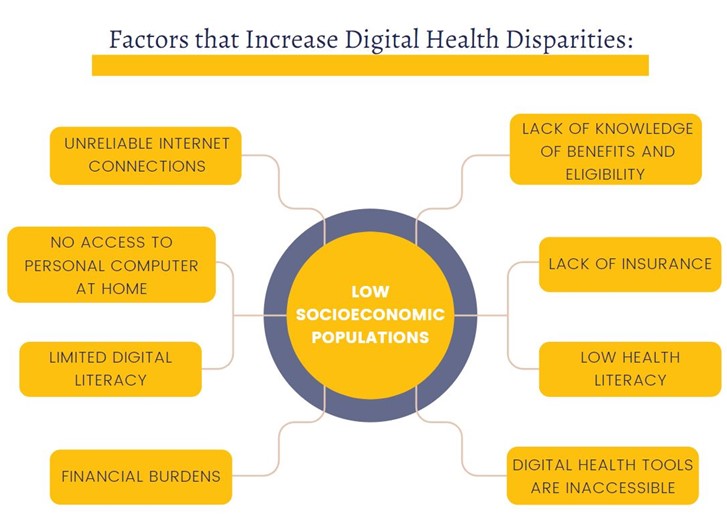
Abstract
Digital health solutions have drastically increased in the wake of the COVID-19 pandemic. Patients now have access to virtual care and healthcare providers 24/7, remote monitoring, and more. Unfortunately, these innovations often don’t reach the low income, disabled, and older population. It is crucial that health IT companies and creators of digital solutions collaborate and curate products for the final user -the patients- with financial restrictions in mind. By increasing access to digital literacy resources and providing more remote and accessible care to disadvantaged communities, the healthcare industry will accomplish equity among patients regardless of income, age, or status.
Introduction
New innovations made to healthcare push the industry towards virtual and AI-based solutions, especially since the start of the pandemic. Telehealth and virtual medicine have bridged a gap that previously seen in healthcare, but the advancements the industry has accomplished as of late are eliminating this progress. Healthcare providers have created drones that deliver blood needed for transfusions[1], digital proof of vaccination[2], and watches that administer medication to patients[3]. However, what good will these health innovations be if they never reach those who need them the most? By advocating for disadvantaged communities through the development of accessible and affordable digital health options, health equity is possible.

Background
During COVID-19, telehealth became an essential component of the healthcare industry that provides quick and effective care to those unable to attend in-person visits. Although the increase in the use of telehealth makes medical care more accessible, the health equity gap is larger than ever. Discrepancies are riddled throughout the social and economic demographics as the lower-class, the elderly, and the disabled are left without care, despite their urgent need for these advancements. The virtual health options available today are not as accessible as they may seem. The assumption that all individuals now have a device that one could use to contact a physician on a telehealth service is not always correct. Low-income and older populations without access to an electronic device capable of this technology would be left without the care that the industry advertises as accessible. Additionally, a third of people ages 65 and older have reported difficulties utilizing digital health tools because of digital illiteracy or a disability that debilitates them from taking advantage of online care[4].

Furthermore, even technologies that provide monitoring for patients fail to be effective for the lower-class. For instance, there are lots of innovations revolving around fitness trackers that provide real-time monitoring of physical activity. As expected, the higher income population that received these solutions saw an increase in physical activity[5]. However, those with less financial opportunities but access to the same innovations didn’t see any improvement in physical activity[2]. This is likely due to the lower-class having less time for exercise, digital illiteracy, and the lack of education on the benefits of these innovations. This is concerning because the lower-income class are less active and in general, would have more health concerns than their higher-income counterparts. Digital health solutions that are not used effectively to provide the same advantages to those who have lower socioeconomic status increase the health disparity and lead us away from health equity.
Solution
The solution to closing the health equity gap in disadvantaged populations relies on collaboration and innovation specific to those people. For instance, the older population could benefit greatly from monitoring systems that can detect if someone with Alzheimer has disappeared[8], to sensors on mobile devices that can detect cognitive decline[9]. However, these technologies are usually not covered by insurance or Medicare[8]. Furthermore, the older generations often lack digital literacy, and therefore, are less likely to use these services, let alone know about them. Therefore, we need to provide these educational resources to them. Health IT companies need to focus on getting their innovations into the hands of their final customers -the patients. They also need to collaborate with the private sector and governments to make their products more accessible.
For the lower-income populations, affordable healthcare solutions such as telehealth are not being used even if they have chronic conditions that would benefit greatly from remote monitoring[10]. The lack of access to reliable internet, a personal computer, and communication about resources available to them is a factor that needs collaboration with multiple sectors to correct[5,6,7]. Additionally, those with financial struggles may not have insurance; if they do, they don’t usually cover outpatient services. While telehealth services provide accessible virtual care, they need to go beyond and provide remote monitoring services to their patients as well. Healthcare needs to shift towards personalized medicine that provides preventive care as well as disease management services to the disadvantaged community. By monitoring disadvantaged patients, we can detect the progression of their diseases faster, and create personalized solutions to manage them.

Health IT companies also need to focus on increasing patient engagement. Even if patients can access digital health tools and afford them, that doesn’t mean they retain long-term use. This can be solved with access to user-friendly interfaces that allow faster communications between patients and providers, as well as promote patient involvement in their own health decisions. Patients will be more likely to use self-service tools to manage their health if they feel empowered to do so. Long-term engagement of digital health solutions for the disadvantaged population can lower health costs overall as well as promote healthier behaviors in patient.
Conclusion
Digital health solutions have made significant progress in the last couple of years, especially in increasing accessible virtual care. However, if health IT companies don’t focus on creating solutions that trickle down to disadvantaged communities, then the health disparity gap will increase. More than ever, the low income and elderly population need virtual health tools suited for them. This includes personalized care, more user-friendly interfaces, education on digital and health literacy, and remote monitoring for chronic diseases. Through collaboration and directly targeting health disparities that make digital health solutions, we can provide healthcare regardless of socioeconomic status, age, and disability.
References
References for this blog can be viewed on LinkedIn – https://www.linkedin.com/feed/update/urn:li:activity:6873608779909398528